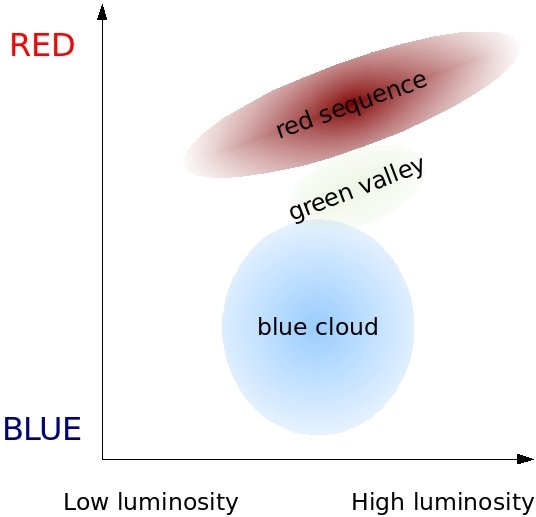
Caption: A cartoon galaxy color-magnitude diagram.
Galaxy color-magnitude diagrams are sort of the galaxy analogues to Hertzsprung-Russell (HR) diagrams for stars.
Features:
- The horizontal axis
is logarithmic
luminosity
for galaxies.
- The vertical axis is
color index for some
representative imagined pair of
passband filter
magnitudes.
A color index is the bluer minus the redder of the pair of passband filter magnitudes and bigger the difference, the redder the color index for the astronomical object. The color index is probably B-V.
But note that in absolute true color galaxies look mostly white??? (unless they reddened by being at high cosmological redshift z???). "Blue" galaxies have more blue light relative to light red than "red" galaxies, but that is NOT the human psychophysical response in their absolute true color.
See Extended Features below for more discussion of the color of galaxies.
- Since circa 2000,
there has been the suggestion that
galaxies
fall into two major populations on a
galaxy color-magnitude diagram:
a blue cloud
(which are probably mostly spiral galaxies
and have the
spiral galaxy mix of
colors with their
blue
color coming from
OB stars mostly located
in the spiral arms)
and
a red sequence
(which are mostly
elliptical galaxies).
Remember that in true-color
both kinds would look mostly white???.
Between the two major populations it has been suggested that there is a relatively unpopulated green valley which is just a whimsical name since the galaxies in the green valley do NOT look green in any true-color sense. They just look mostly white???.
There are green bean galaxies and green pea galaxies, but they only look greenish in certain standard imaging passband filters, probably NOT in true-color.
- Are the
red sequence
and blue cloud
really distinct populations?
Maybe NOT.
Eales et al. (2018) argue that biased
observations created the apparent distinction.
There really is a CONTINUUM between the
blue cloud
and the red sequence,
and there is NO relatively unpopulated
green valley.
But the issue is NOT fully settled circa the
2020s.
- The essential difference between the two populations of
galaxies
(treating them as distinct by some conventionally defined line if NOT otherwise) is that
the blue cloud galaxies
have a lot of star formation
and the
red sequence galaxies
do NOT have a lot: in the extreme limit very little to none.
The red sequence galaxies are quenched galaxies: i.e., those for which star formation rate (SFR) is less than ∼ 10 % of SFR in galaxies recognized as star forming galaxies (mostly spiral galaxies and irregular galaxies) and maybe star formation is turned off completely (see, e.g., Cimatti 2020, p. 54). As a shorthand, we usually say quenched galaxies have NO star formation without qualification or star formation turned off without qualification.
- The shown colors are meant to be representative.
Unquenched galaxies
have a relative excess blue
light only near their
star forming regions
where
hot young blue main-sequence stars (mainly OB stars)
(hereafter just OB stars)
live their whole stellar lifetimes
which end when they explode as
core-collapse supernovae
(if their masses exceed ∼ 8 M_☉: all
O stars
and the larger B stars).
However, in absolute true color,
the regions of excess blue
light still just look
white hot???.
Of course, the
star forming regions
themselves are dark dusty
molecular clouds
and do look dark or brown
in absolute true color.
Overall, the
unquenched galaxies
would look
white hot
(see Temperature of a "White Hot" Object,
Carine Fang, 2001, bottom of page;
blackbody_spectra.html).
Similarly, quenched galaxies look white hot or somewhat yellow-white in absolute true color particularly as their stellar effective temperatures are in the white hot range ∼ 1500--11000 K see Temperature of a "White Hot" Object, Carine Fang, 2001, bottom of page; blackbody_spectra.html). Thousands of gigayears in the future (wildly extrapolating to the Λ-CDM model cosmic future), the quenched galaxies will become redder in the photometric sense (i.e., in B-V color index) since the only stars left doing nuclear burning will be red dwarfs which have lifetimes up to ∼ 10**4 gigayears (see Wikipedia: Red dwarf: Description and characteristics). However, the quenched galaxies will still probably look white hot in true color (as seen in space) because their stellar effective temperatures are ∼ > 2300 K which is still in the white hot range.
- To confuse the discussion of
galaxy
color,
astronomers
measure color
using the
color index
B-V which is
frequently just called color.
Lower B-V is bluer,
higher B-V is redder.
So blue cloud galaxy
(which are
star forming
galaxies)
are lower in B-V,
and
red sequence galaxies
(which are
quenched galaxies)
are higher in B-V.
And
green valley galaxies
are intermediate in
B-V and do NOT
look green in
true color.
Image link: Wikimedia Commons: File:Galaxy color-magnitude diagram.jpg.
Local file: local link: galaxy_color_magnitude_diagram.html.
File: Galaxies file: galaxy_color_magnitude_diagram.html.